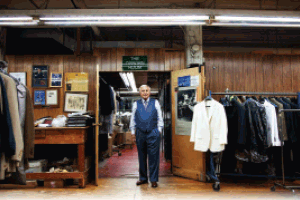Off the Top of My Head

Need a new sheitel but don’t want to mortgage your home? Here’s everything I learned about buying a good sheitel on the cheap

P eople work on heuristics — rules of thumb — and two of them in the sheitel world are costing people a lot of money:
1. You get what you pay for.
2. If this is how everyone does it it must be the right way.
I’m telling you these “hairistics” are as dated as your mother’s teased bangs.
I was desperate for a new sheitel but didn’t have time for the process. Plus I’m cheap. Then a friend told me her sister had purchased a wig from AliExpress. Yes that AliExpress where you buy cute moccasins and headbands for your daughters for pennies and wait three months for them to arrive. If you look you’ll find wigs too. Put “Kosher Jewish Wig” into the search bar and you can get lost for days.
Long story short I look awesome in my new AliExpress sheitel and would do it again… and again. And I’ve spoken to a few people who’ve purchased AliExpress sheitels and they echo my enthusiasm. And at $300 for 16 inches I feel like I can buy a sheitel for every day of the week.
Chinese Chops
Want your own? If you’ve got a little can-do spirit (and by that I mean really a little — I hardly have any and I did it) here are the details.
I used Jack of TsingTao Wigs the same seller used by other people I spoke to. His English is not the best and he communicated more efficiently before the sale than after it. Still I felt secure and comfortable with my purchase during the process for two reasons: AliExpress’s customer satisfaction guarantee and the fact that I was paying with American Express which is known for customer protection.
Jack has a wig factory in Qingdao China and employs 80 people. He told me he supplies wigs to some well-known New York–based lines of sheitels. Honestly I took everything he said with a grain of salt but then again how would he know those company names? The wig came pretty quickly — around two weeks after I placed my order.
There’s no standard website for placing your order; you e-mail Jack and he creates a custom page for you to order from. There are several choices you need to make: color length style (all the same length or layered) hair texture density and cap size. All the information about options can be found on Jack’s AliExpress webpage and there are links to his website for more information.
I ordered a #6 in color which should have been a light brown but his #6 is more like a 2 or 4 a rich deep brown. I spoke to Naomi who’s ordered about ten wigs from him and she confirmed this experience. But there’s nothing a few added highlights (or the sun) can’t handle.
For an extra $10 to $20 you can have greater hair density. If you like a lot of hair and volume that’s a good option and price. Miri who has one sheitel from Jack opted not to get more density; though her sheitelmacher cousin said Miri’s sheitel is on the thinner side to Miri it’s perfect the way it is.
Hair texture is another choice you’ll have to make. On Jack’s website, you’ll see pictures of different hair textures ranging from stick-straight to tight curls. I ordered the straightest possible; others I spoke to ordered a range from straight to natural waves. We’re all happy with our s’choirah. Sorry, curly heads — I know you’re dying for a naturally curly sheitel, but I can’t vouch for them. One of you try them and let the world know.
One more thing to consider is cap size. Jack gives instructions on his website for measuring your head for the most accurate size. One person I spoke with has a very large head, and tight caps are always an issue. She asked Jack about the measurement and ended up ordering an XL cap, paying an extra $30 for it. “It’s one of first sheitels I’m fully comfortable in,” she says. It’s something to keep in mind for those of you who have extra room to store your brains.
My sheitel showed up in a small bag, folded up like a rag. I put it on, ran to the mirror, and discovered it was super flat. My sister Malky Fulda, a licensed cosmetologist, came to the rescue with instructions on how to dry it (upside down) and to make sure I parted the hair before it dried (preferably before I even washed it) so it would set the way I wanted.
I washed it and half expected the hair to melt with shampoo; it did not. Naomi, also skeptical with her first purchase, was sure the hair must be dyed, so she washed hers several times to see if any color would come out, but the waters ran clear. My sheitel dried beautifully. I could’ve worn it without doing a thing; it just needed a trim to freshen the edges. “A miracle wig,” Naomi calls hers. With the naturally wavy hair in her wig, she just washes and wears it.
After the sheitel dried, I noticed a few patches of hair along the front hairline that were way shorter than 16 inches. Before hyperventilation kicked in, I told myself I could just cut bangs that short. I considered returning it, but I didn’t want to because the hair was so nice, and the cap so comfortable. And like I would really send something back to China! I can barely return anything I ordered on Amazon Prime.
I e-mailed Jack, who responded, “Front short hair is baby hair!” I replied that I hadn’t ordered baby hair, and asked if he can do anything for me. He never responded, and I never pursued. Lesson learned: don’t order baby hair; he doesn’t know what it’s supposed to look like.
Also, I suspect he puts everything through Google translate. I tried doing a reverse translate, and discovered that the word “question” translates to “problem” according to Google, and if they botched on that, I can’t expect anything to come through clearly.
Another iffy option is the lace front. I know someone who ordered one through Jack and promptly removed it, but Miri and Naomi are happy with theirs; in both cases, it just needed to be taken in a little.
My sister cut my sheitel. So that was free; I just owed her lunch. Before cutting, she raked her fingers through the hair and gave her assessment: the hair felt great, silky, and fine. She did point out some issues with the hairline, a few errant hairs sewn in the wrong direction. For the style I wanted, it didn’t make any difference. And ultimately, she brilliantly cut and blew the sheitel to blend the shorter “baby” hairs into the style, so I did not get stuck with bangs ending in the middle of my forehead. Thank G-d!
Miri’s sheitelmacher cousin assessed the wig and deemed it to be on par with the $1,500 wigs she sells. She was pretty surprised, too, because she had seen other AliExpress wigs and pronounced them “plastic.” When Naomi asked other sheitelmachers to assess hers, she got a value range of $1,500 to $3,000. As for the price they actually paid, it ranged from $280 to $380!
I’ve been wearing mine a few weeks, and apart from getting used to the style, I’m loving it! The cap is super light and comfortable, and the hair hasn’t melted yet. (Just kidding.) It gets a little knotted at the ends sometimes, but nothing noticeable or bothersome. I’d do it all over again.
Pre-Owned Plaits
For those of you who are more risk averse, or who want a selection and to see what you’re buying before you do — there are other options for sheitels that don’t require selling your firstborn to afford them. There is a growing secondary market of consignment wigs. I got the lowdown from Rimona of MOPS Wigs in Hillside, New Jersey, and Rae Lloyd of Doppelganger Wigs in Monsey.
Here’s how consignment works. For the customer, it’s simple, you’re buying a sheitel; you just happen to not be the first owner. Think of it as a certified pre-owned car, not just a used car — it’s been evaluated and deemed to be a good product.
People choose to consign their wigs for many reasons. Ideally for Rae, the sheitel was an impulse buy at a sale and the woman was pressured and later realized the color was off, or cap size wrong, or she hated the cut. “Some wigs come with tags still attached!” Rae says.
Kallahs are frequent consigners of wigs, too. Too often they try on a sheitel, it’s uncut, they have no imagination for what it’s going to look like or what they want or need, and very quickly after the wedding, they resent their sheitels. To cut their losses and not hold on to a sheitel they never wear, consignment is a viable option. There are also people who live the consignment cycle, buying and selling consignment wigs every six months or year.
Both Rimona and Rae explained the process of consignment so you can feel secure in your purchase. People bring their sheitels in or send pictures, and the sheitels get assessed for their value. “If it’s ready for a gemach, we don’t accept it,” says Rimona. Rae says most wigs are under two years old; on occasion she’ll take something older, but only if it’s in prime condition. The price of an older wig will subsequently be significantly lower.
Both Rimona and Rae examine the wigs for wear and tear, paying attention to the inside of the cap, whether the hair is oxidized, thinning, or very knotted, how many times it was colored, etc. After this, they’ll wash the sheitel to see how it dries naturally. Finally, it’s evaluated on different criteria to arrive at a price. For Rimona, the three main criteria are brand, length, and color, taking into account factors like hair density and add-ons like baby hairs. Rae’s evaluations are similar.
The easiest wigs to resell? Long, naturally wavy wigs in basic browns, both say. But that’s based on current styles for young people. With summer, lobs are very popular and quick sellers, too. Blondes are tricky, says Rimona, because there are so many shades: ashy, white, strawberry, dirty. Every blonde is looking for her unique shade.
Interestingly, Rae told me that many brunettes will buy a blonde wig because they love the quality and cut so much, and just color it. Reds are a hard color, but they sell fast, because that’s the most expensive color to buy naturally. (My redheaded sister-in-law spent $2,500 on a 12-inch wig. Twelve inches!)
Two colleagues of mine bought wigs though Rae, and both would do it again. “Why would I pay full price, when I can get the same thing for half?” Rina Kasper, my co-teacher, said bluntly.
Rae echoed that sentiment. “People come because they feel good about the quality and feel like they’re getting a deal. There’s no shame in consignment.”
Rae and Rimona have showrooms and large selections to choose from. They’ll also reach out to customers through social media, alerting them to new wigs and styles in stock, giving followers get first peeks and dibs on new consignments.
While Rimona has a full-service salon in Hillside, she has taken her show on the road and traveled to Atlanta, Memphis, Cincinnati, Chicago, Milwaukee, and Los Angeles, bringing her selection of wigs and affordability to out-of-town communities. Rae has a “try it before you buy it” policy — she ships a wig (often worldwide) and the customer has two days to decide whether to keep the wig or return it.
MOPS Wigs has a full-service salon, where they do wash-and-sets and wig repairs, sell accessories, and cut wigs on the spot. Doppelganger Wigs recommends different stylists and repair experts. “Eighty percent of my customers put on a wig and walk out,” Rimona says. The rest need a trim in length, or bangs, some want to add color, lace fronts, or baby hairs.
So brass tacks — l’maiseh, how much are you looking at? Rimona’s wigs start as low as $500 and go up to $1,200. She says the average price is between $700 to $950. Rae’s lowest costs around $450, but that’s rare, she admits. Depending on the piece, some consignments can be as much as a new wig, but the average price is between $600 to $1,100.
I always love a good hand-me-down. Who thought you could do that with sheitels, too?!
Good as New
If the thought of a secondhand wig has you reaching for Purell, let’s discuss new wigs for a moment.
Brooklyn sheitelmacher Breindy Dembitzer sells many different lines, high to low, but if you ask her which to buy and what she wears, she says, “Cheap.” She is very assertive. “If you have a good cut and a good stylist, you can look amazing in any wig.”
What makes wigs cheaper? Processing. That means stripping the hair of its natural cuticle and processing it with chemicals to achieve a particular texture and color. Because it goes through treatments, the original hair does not need to be of the highest quality — hence, it’s cheaper. Doesn’t sound like a selling point to me.
When it comes to food, “processed” is the enemy, but Breindy says otherwise for hair. “There’s a consistency in the product because it’s processed, and you’re less likely to get a lemon.” But if you do? Most companies, says Breindy, stand behind their products and are easy to work with. She recently sent a sheitel back to the manufacturer for a customer with barely an explanation; the company looked at it and accepted it, and sent back a new wig.
“Find a sheitelmacher you love and trust and follow her blindly. That’s where the magic is,” Breindy advises. “You can get a $5,000 wig, but if it’s not cut well, or styled nicely, it’s going to look like a mop. It’s not the hair, it’s what you do with it,” she insists.
To be honest, I’m a skeptic — my mother brought me up on “quality, not quantity.” But then again, I’ve had the same person cut my hair since third grade. I’d sit in her chair and literally just say, “Make me gorgeous,” and let her scissors fall where they may. So I do get the style-and-trust concept.
I ask her about the quality, and how long these sheitels last. Four to five years is the average lifespan, according to Breindy, for people who care for their wigs. (Less for those with two left hands.) But it should look fresh and great for two to two and a half years.
You may have to put some money into your sheitels, adding hair, baby hairs, coloring — but these costs are a fraction relative to three-grand-plus. Breindy concedes that the more expensive wigs may have more comfortable caps, or the hairline may be a bit better on closer examination. Still, to the naked eye, most people can’t tell the difference between an expensive wig and a cheaper one. These lower-end sheitels run from $1,300 to $1,600, with length being the determining factor.
Another option for those who want luxury quality without spending $5,000? See Charlene Aminoff. As her way to pay it forward and give back to Hashem after a medical miracle, she founded Gali Couture in Great Neck, New York. “It’s not a business,” Charlene says, “but a project.”
Charlene had a factory built to manufacture her own wigs, thereby eliminating one middleman and cutting costs. Another way Charlene gets her prices down is her buying power. It’s basic retail economics: The more you buy, the cheaper the price. Most wigmakers purchase only a few kilos of hair at a time, while Charlene generally buys out hair suppliers’ entire stock, so the price she gets is significantly lower than most. Currently she has an inventory of 8,000 wigs!
The basic price point for a Gali Wig, shoulder-length or longer, is $1,650. For shorter lengths, the price falls between $750 and $1,200. But hardly anyone pays full retail price, Charlene says. She’s constantly running giveaways and contests for people to get money off their wigs. She also has a referral system; for every person you refer, you get $200 off your next wig purchase. Additionally, Charlene will ask (she’ll ask, you don’t have to muster the courage to tell) each customer if her husband is in kollel, chinuch, or Hatzolah, and she’ll offer an additional discount. The day before I talked to Charlene, she sold a brand-new sheitel to a woman who, after all her giveaways, referrals, and discounts, paid $375. Not bad!
Because the salon is only open on Mondays and Tuesdays, Charlene selected distributors to carry the Gali Couture line. While these distributors make a profit on the wigs, they may not sell it for higher than the Gali Couture salon pricing, keeping it affordable for everyone, even if you can’t make it to Great Neck.
So while I’m running around in my AliExpress sheitel, enjoying the slack jaws when I tell people where I got it, and what I paid, I’m feeling calmer and empowered. Covering our hair is a beautiful and special mitzvah, yet due to the price point of wigs, it can become a source of great anxiety for many women, myself included. And now, while they’re still not cheap — they’ll never be cheap — I know they don’t have to be the mortgage payment I always thought them to be.
Dare I Say Synthetic?
Synthetics can be a great inexpensive option for a rain sheitel, or an everyday run-around-the-house sheitel. They generally last about six months, and run from $20 on a beauty supply website to $400 for upscale synthetics. A lot of people won’t even notice it’s synthetic. Just don’t tell them; it’ll be our secret.
Fall for a Hat Fall
Less expensive than a regular sheitel — because they have half the hair — hat falls also don’t have the most complex part of the sheitel: the scalp and hairline. Because it’s just about hair coming out from beneath a hat, feel free to go a cheaper route. Also, you can make your own hat fall. Take your dead or dying sheitel, cut the hair on top until the cap, so a hat will lie flat, and viola — a hat fall for free!
(Originally featured in Family First Issue 558)
Oops! We could not locate your form.













